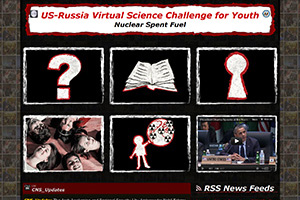A media release issued by the State Department touted examples of US-Russian cooperation, including a youth science program being developed and implemented by CNS: The US-Russia Virtual Science Challenge for Youth program. High school students from the two countries meet through a website developed by CNS. They investigate solutions for managing the world’s 240,000 metric tons of spent nuclear fuel. If not managed properly, spent fuel could cause a widespread release of radiation or be used in the development of nuclear explosives.
Students are using unclassified information to conduct scientific research on topics such as nuclear weapons, nuclear reactors, the nuclear fuel cycle, and high-risk materials such as highly enriched uranium and plutonium. Students then focus on options for handling spent nuclear fuel, especially plutonium. They are researching scientific options available for spent fuel management, proliferation risks that different technologies pose, and alternative solutions. All teams will come together at the Virtual Science Fair to present their final findings and proposed solutions.
The project is funded by the US Department of State’s Bureau of Educational and Cultural Affairs. Last fall the department chose CNS as the sole US organization in the nation to conduct the project.

